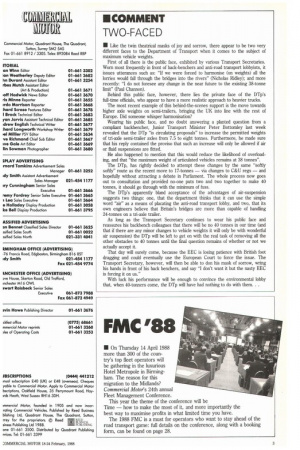• COMMENT
Page 7

If you've noticed an error in this article please click here to report it so we can fix it.
• Like the twin theatrical masks of joy and sorrow, there appear to be two very different faces to the Department of Transport when it comes to the subject of maximum vehicle weights.
First of all there is the public face, exhibited by various Transport Secretaries. Worn most frequently in front of back-benchers and anti-road transport lobbyists, it issues utterances such as: "If we were forced to harmonise (on weights) all the lorries would fall through the bridges into the rivers" (Nicholas Ridley); and more recently: "I do not foresee any change in the near future to the existing 38-tonne limit" (Paul Channon).
Behind this public face, however, there lies the private face of the Dip's full-time officials, who appear to have a more realistic approach to heavier trucks.
The most recent example of this behind-the-scenes support is the move towards higher axle weights on semi-trailers, bringing the UK into line with the rest of Europe. Did someone whisper harmonisation?
Wearing his public face, and no doubt answering a planted question from a compliant backbencher, Junior Transport Minister Peter Bottomley last week revealed that the DTp "is circulating proposals" to increase the permitted weights of tri-axle semi-trailer axles from 7.5 to eight tonnes. Furthermore, he made sure that his reply contained the proviso that such an increase will only be allowed if air or fluid suspensions are fitted.
He also happened to mention that this would reduce the likelihood of overloading, and that "the maximum weight of articulated vehicles remains at 38 tonnes".
The DTp, has rightly decided to attempt these changes by the same "softly softly" route as the recent move to 17-tonnes — via changes to C&U regs — and hopefully without attracting a debate in Parliament. The whole process now goes out to consultation and provided no-one puts two and two together to make 40 tonnes, it should go through with the minimum of fuss.
The Dip's apparently bland acceptance of the advantages of air-suspension suggests two things: one, that the department thinks that it can use the simple word "air" as a means of placating the anti-road transport lobby, and two, that its own engineers believe that Britain's bridges are more than capable of handling 24-tonnes on a tri-axle trailer.
As long as the Transport Secretary continues to wear his public face and reassures his backbench colleagues that there will be no 40 tonnes in our time (and that if there are any minor changes to vehicle weights it will only be with wonderful air suspension) the DTp will be left to get on with the real task of removing all the other obstacles to 40 tonnes until the final question remains of whether or not we actually accept it.
That day will surely come, because the EEC is losing patience with British foot dragging and could eventually use the European Court to force the issue. The Transport Secretary, however, will then be able to don his mask of sorrow, wring his hands in front of his back benchers, and say "I don't want it but the nasty EEC is forcing it on us."
With luck his performance will be enough to convince the environmental lobby that, when 40-tonners come, the DTp will have had nothing to do with them.
























































































